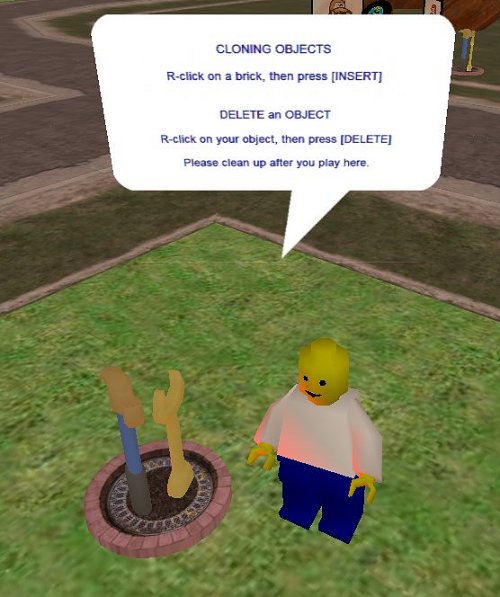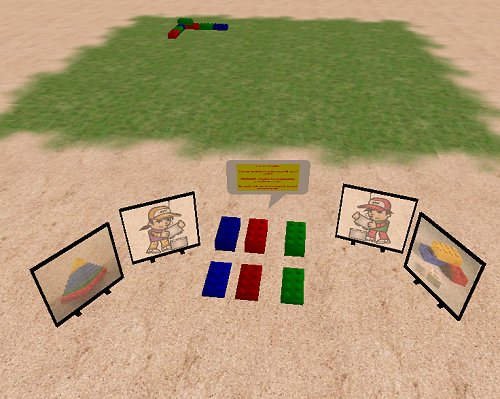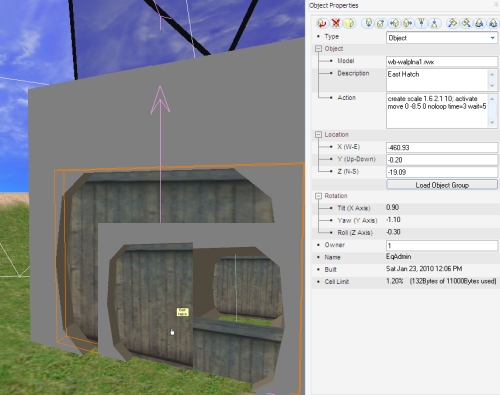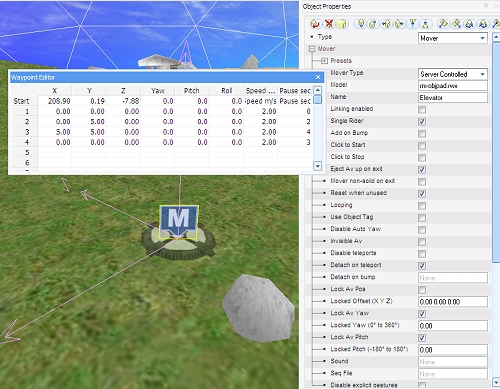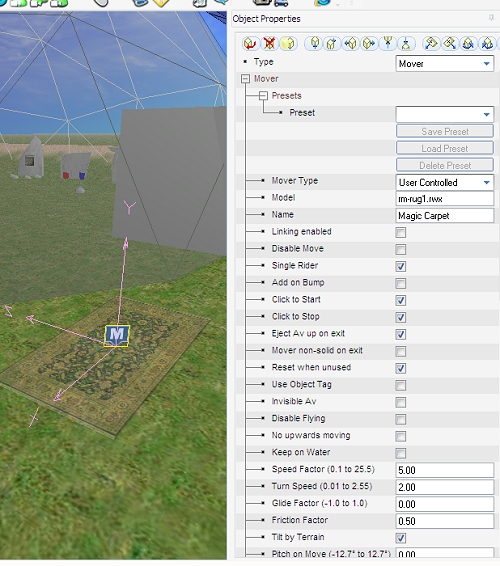Noob today, 1337 tomorrow …
So I have begun making a zone specifically for noobs, builder noobs in particular and it struck me how complicated building with any sort of quality actually is.
I figured I should start with a gimmick, so dived into Wings3d (a favorite mesh editor) and sculpted a HAMMER and a SPANNER – nothing says construction to me like tools. I decided they needed to be on a pedestal, rotating and glowing magically, as they do in real life. I am, initially, doing the whole “Lego” thing because nothing quite matches it as a modular metaphor, plus we are dealing with a primary clientèle so I figure I should try to talk to them where they are.
I decided that the tutorial zone should be non-linear, but if you wanted to follow the skills developmentally in a linear fashion that should be possible also – to that end I warp between stations in the order I think makes sense. WARPING is a neato transition trick that is different to teleporting – it is like a fast run to your destination – this way you still get a sense of space and a feeling like you are travelling – I think it is most effective here in the metaphor of a skills journey also.
So, in this sequence, punters click on the rotating and magically glowing toolbox to progress to the next step if they want to discover things sequentially, or walk/fly on their own. I think this is a reasonable way to do this, but am open to suggestions.
In Activeworlds, you need a source object to make a new object … this solves the age old question because you can take a chicken and make an egg, or visa versa, but first you have to CLONE an object from something already there. R-Click is the gateway to editing (including clone, delete and other stuff).
Next I figure you need to know how to move it around. Activeworlds, like Secondlife, lets you steer your object on it’s current plane using arrow keys. Key-presses equate to steps and there are three step sizes (50cm, 5cm and 1cm) achievable using raw arrows, shift+arrows and shift+control+arrow keys. raising and lowering an object is achieved using the number pad +/- buttons (step sizes and modifiers work the same) … there is an interesting rub – you NEED a number pad to be effective in Activeworlds, else you have to resort to reassigning keys that sometimes almost, kind of sort of, nearly work.
Rotating objects gets a little trickier to explain – if the object is in it’s original grid-aligned position, then controlling pitch, rotation and yaw is “relatively” straight forward – using PgUp|PgDn, Home|End and /|* buttons on the NUMBER PAD you rotate the object in x, y or z relative to the directions of the axes for that object. Rotations happen in degrees (15, 1.5 and 0.1 increments using movement modifier keys like moving) so quite precise alignment and swizzling of objects is possible. Pixel perfect is a little more tricksey as, depending on your graphics card’s ability and the client settings, some objects rezz slightly out of alignment, even tho they are not (maybe that is just me being anal, but that erks me – one particular panel in a hallway I tweak every time I walk past it … but I digress).
I am not sure how well my instructions make sense to kids who are still in the concrete operational stage (and are yet to gain the ability to envisage things in 3d), still I guess concise facts are a good thing. I had “Michael12” (a strolling year6 of no fixed address) try them out for me in-world and he said it was cool, so I guess that means it was almost non-gibberish.
Re-sizing objects, like rotating requires a little 3d spatial awareness and I am not at all sure what I am saying makes any sense, yet. I need to mull over this – I think something diagrammatic might work better.
In all, the beginnings of the sculpture park are promising, I think they need little stages and backdrops, so will make them in keeping with the welcome wall I think as it is a simple yet effective way of creating a private space in an otherwise open world – that and the rust goes well with my sculpture so it is all visually continuous.
So … to test how well Cybernauts get the whole basic building block thing, I have created a stacking competition – using iLego, we are going to collaboratively build a pyramid. the bricks stack neatly side by side in whole steps, are 60cm high so stacking them on top of an existing row is manageable … we shall see how it goes. I guess this is one way to measure success.
Movers and shakers
I am working on a bunch of ideas, but common things like “airlocks” and doors are the first to get a guernsey. In our homebase, we will need airlocks – little intermediary chambers in between sectors.
There are a bunch of building primitives, so i made an elongated tunnel, purloined a “fence” segment [looked sort of industrial] and programmed it to slide down on activation – nothing new here. In the production airlock there will be a wall-mounted button to do this also, that would look more natural. It did however get me thinking about moving objects in general.
Now I have seen vehicles, lifts and other essential things in other Activeworlds, so decided it was high time I understood how these things work. It seems there are 3 “classes” of objects termed “movers”.
Server-controlled movers are objects that users ride but do not have any control over the path they take. Lifts and busses are examples of this sort of mover – you “hop on board” and initiate the trip somehow [activate = click, bump = coming in physical contact with] and the object then follows the pre-set path with the user on/in it. All movers let you “detach” yourself from them via a button-bar icon, but it would be normal to go for the full ride and have the mover detach itself from you automatically when you are safe, at your destination and most importantly stationary.
There are some nifty controls available when defining these things. The movement is controlled via a “waypoint editor” – you control the world coordinate displacement in XYZ, velocity, as well as the bumpiness of the ride [rock and roll] with pitch, yaw and roll. There are some complications using “add on bump” when you try to get off the mover – each movement is another “bump” whilst on the surface of the mover which can get interesting [or less so if you do not want to re-take the journey].
The amount of control you have here is quite feature-rich and if you choose a suitable “pad” object, quite natural movements can be achieved. This sort of mover has natural applications for lifts, travel tubes, roller coasters and so on where you get on, strap in and hang on.
User-controlled movers are a lot of fun – naturally I decided I needed a “magic carpet” and decided you would need to climb on board and then click to say you were ready for a ride [and again click when you wanted to get off]. Walking [and flying] unassisted is necessarily tedious in most virtual worlds – a user-controlled mover lets you go fast and can make the journey much more entertaining. Essentially, a user-controlled mover “enhances” player movement – speeding it up, making flying much more risky – the control you have over this form of transport is fairly detailed – I had the carpet dipping and rolling, banking and flapping on tight corners, so violently in some trials that it actually flung me off when I banked too hard. It is rare that I howl with laughter whilst experimenting but this was fun – the avatar and the object are also separately configurable – this means that, although the carpet is wildly flapping underneath me, my avatar is steady … or the other extreme where you lean, tilt and get chucked about.
Cars, spaceships, skateboards and gliders are but a few obvious applications of this type of mover. The world has a bunch of cars but I could not find one in the Q2 sim that actually let me drive – it might be that the config is confusing for little kids – I am sure however we can come up with “vanilla” recipes of setting for types of vehicles.
The third class of mover is a “pick-up” item that is attached to some part of the avatar [as per location tags above] – they are similar to user-controlled movers except you carry them around and choose when to wear them. I can see jet-packs, helicopter beanies and rocket-powered rollerblades as applications for this sort of mover. Because they are attached to the avatar, seeing them to remove them is problematic [indeed – server and user-controlled movers need to be big enough for you to see if you are relying on using activate to use them]. These become active when you attach them to you or hold them. Will play some more here when an application surfaces – they do not appear that different to user-controlled movers to warrant time now.
So what? I can see movers being very useful – transporters between locations, walk-through and guided tours of facilities, personal transportation and a bit of fun – if an oldie like me gets the giggles trying to hang on on a magic carpet ride, then I think our punters might like it also – especially if they can make and configure them themselves. Races take on a whole new meaning if you limit their speed setting but let them play with other parameters and get them to take to an obstacle course.
